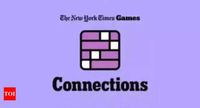The New York Times Connections game, developed by associate puzzle editor Wyna Liu, has captivated word enthusiasts with its challenging daily brain teasers. The game, released at midnight each day, tests players' linguistic skills and creative thinking by asking them to group seemingly unrelated words based on common themes. On March 18, 2025, puzzle #646 presented players with another set of challenges, requiring thoughtful analysis and clever wordplay to master.
For those unfamiliar, Connections offers players spice and variety by featuring three difficulty levels: Easy, Medium, and Hard. Each puzzle consists of 16 words, which players must sort out, grouping them based on shared characteristics. This approach sets it apart from traditional crosswords, inviting lateral thinking and innovative word association. Today's edition was particularly tricky, featuring themes ranging from applicable verbs to aspects of Greek mythology.
Players are often encouraged to tackle the puzzle through gradual exploration, as they aim to identify connections without becoming overly frustrated with its intricacies. Hints are available but are kept intentionally vague to preserve the thrill of solving the mystery independently. The four hints for today's puzzle categories are both strategic and insightful:
- Yellow: Unique and unparalleled
- Green: German words
- Blue: Word remains the same when multiplied
- Purple: Breaks the standard pluralization rules
Today’s categories for the March 18, 2025, Connections puzzle were:
- Exceptional (Yellow): REMARKABLE, SINGULAR, SPECIAL, UNIQUE
- German words (Green): ANGST, DIE, KINDER, WURST
- Plural animals identical to their singular forms (Blue): DEER, SHEEP, SHRIMP, SQUID
- Plural words very different from their singular forms (Purple): DICE, LICE, MICE, OXEN
Starting each game, players have four lives, which are lost with incorrect guesses, making strategy and careful deliberation key to maintaining gameplay. The feedback from each submitted grouping is immediate—correct groupings yield color-coded confirmations, whereas mistakes count against the player’s total lives. Once all four groups are correctly identified, players can revel in the satisfaction of their success, sharing their results on social media—a feature which has bolstered the game's popularity enormously.
The Connections puzzle is not just about solitary play; it thrives on community interaction. Many players strategize together or share thoughts on forums about the challenges they faced. Discussions pop up across social media platforms, transforming individual gameplay experiences to collective challenges. This brings to light the game’s charm as not just another word puzzle but as part of the growing social fabric of puzzle enthusiasts.
For those struggling with the intricacies of today’s puzzle, it’s important to absorb small lessons from every try. Each mistake helps refine your approach for future puzzles. Keep ideas flowing and don’t hesitate to think outside the box; some incredibly clever groupings are defined only by lateral thought processes and cultural references.
Whether you're just getting started with Connections today or are already well versed, each day presents new opportunities for brain teasers and vocabulary enhancement. The game continues to challenge and amuse its players and with so many social opportunities attached, NYT Connections fosters both individual growth and community spirit. For those who enjoy diverse puzzles, other offerings from The New York Times, such as Wordle, the Spelling Bee, and more, could provide additional challenges and avenues to engage your problem-solving skills.
Keep practicing, enjoy the process, and don’t forget to check back tomorrow for another exciting round of Connections or share your scores and strategies with friends. Each day, another puzzle awaits to test creativity, vocabulary, and sharpen analytical skills!






